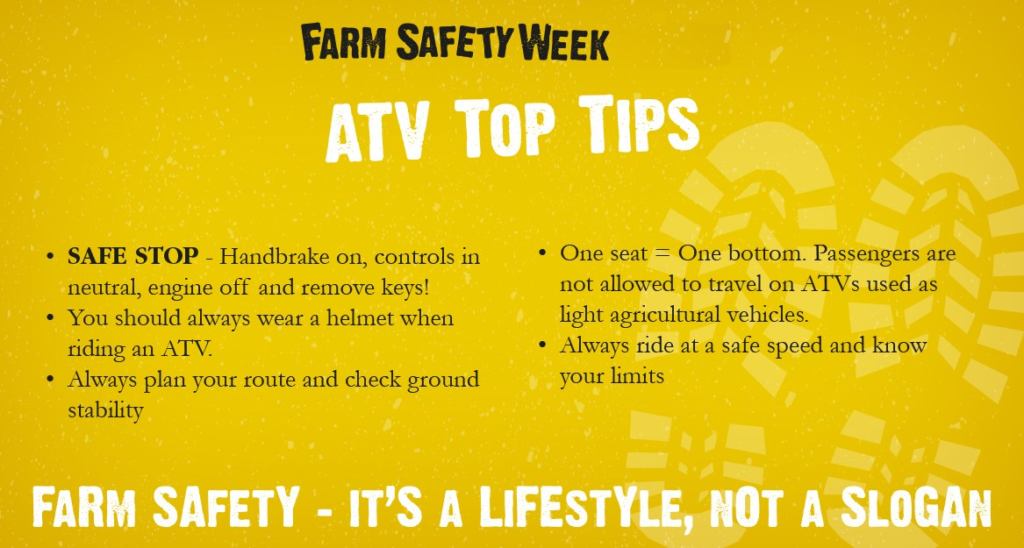This Farm Safety Week farmers are being asked to take a few minutes to consider how to make their workplace safer.
The main causes of serious or fatal injury associated with quads, or All Terrain Vehicles (ATVs) are from:
- Being thrown off during vehicle overturns or after loss of control;
- Collisions with structures, trees, other vehicles etc;
- Being trapped/asphyxiated under an overturned machine;
- Pedestrians being struck or run over by ATVs.
The AgriLand team has put together a few tips on how to make sure your ride on the quad doesn’t end in disaster.
Training
It is a legal requirement for employers to provide adequate training for employees who use work equipment such as ATVs or quads, and to make sure that only employees who have received appropriate training are permitted to ride them.
What you may not realise is that the same requirements apply to the self-employed.
You can get details of suitable training courses from franchised ATV dealers, manufacturers’ websites, Lantra, the Forestry Commission, EASI (European ATV Safety Institute), the British Off Road Driving Association (BORDA) and through colleges and training providers and if you ask nicely some dealers will also even offer training as part of the sale.
The importance of head protection
Sit-astride ATVs are not fitted with either a cab or roll bar, so your only protection is what you wear. As a result, head protection is vital.
Many ATV fatalities in the UK have been caused by head injuries. Helmets would certainly have prevented most of, if not all, these deaths.
Helmet types suitable for ATV operations, depending on the circumstances, are motorcycle helmets, equestrian helmets, specialist ATV helmets, cycle helmets and mountaineering helmets.
All helmets should be manufactured and tested in accordance with the current relevant EN/BS standard, have a chinstrap and be capable of being used with suitable eye protection.
The harder the surface and higher the speed, the greater the degree of protection needed.
Forestry helmets and industrial hard hats are not acceptable for use on a quad.
You should also wear clothing that is strong and covers your arms and legs. Gloves are useful for protection and handlebar muffs can help to keep hands warm in cold weather for good control of the machine.
Wear sturdy, ankle-covering footwear – for example, boots or wellingtons that are strong, supportive and have good wet grip.
A visor or goggles will also protect your eyes from insects and branches.
Passengers
The long seat on a conventional sit-astride ATV is to allow operators to shift their body weight backwards and forwards for different slope conditions, a technique known as ‘active’ riding. It is not for carrying passengers.
Manufacturers often display a sign on machines prohibiting passengers and this message is also repeated in operator manuals.
Do not carry a passenger in a trailer behind an ATV as any movement can make the machine unstable, particularly with independent rear suspension and trailers with axles wider than the ATV.
Route planning and stability
Accidents can often occur where ATVs are driven on new routes over steep ground for the first time, or are carrying or dragging destabilising loads.
When travelling over rough terrain, get to know your own ground and stick to planned routes where possible.
Walk new routes if necessary to check for hidden obstructions, hollows or other hazards. Allow for changes in ground conditions and for the destabilising effect of loads or attachments.
Know your vehicle
Most ATVs have no differential and so do not handle in the same way as other machines. This means that when you turn, the vehicle tries to keep going in a straight line.
When cornering on an ATV with no differential, or with the differential lock engaged, where your body
weight needs to be positioned depends on how sharp the corner is and on how fast you are going.
Correct body position allows you to transfer weight to the outside of the turn through the footrests while maintaining balance with the torso.
This lets the inside wheels skid slightly allowing the ATV to make the turn properly.


